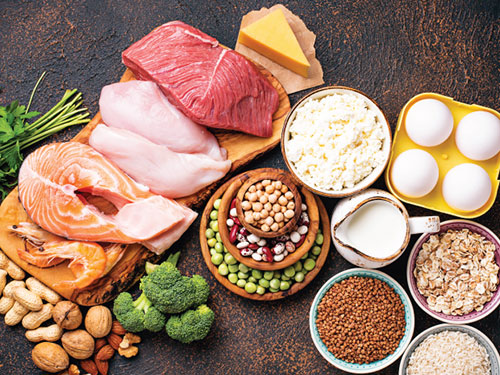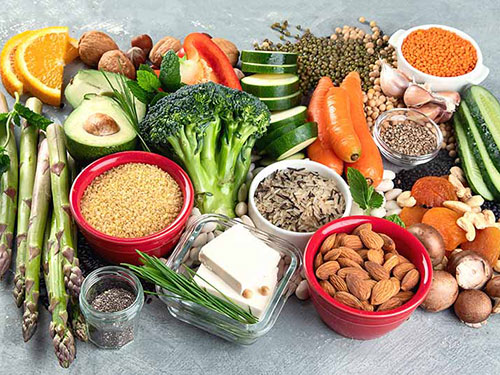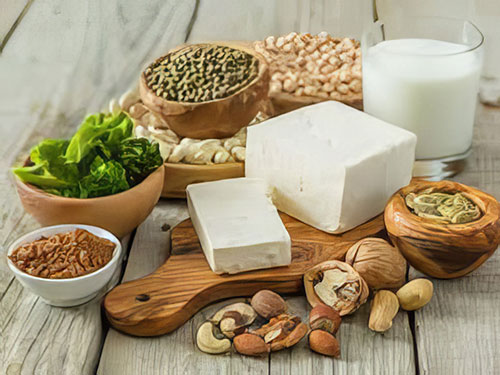
Fact Sheet FS1055
The Protein Group is an important part of a well-balanced, nutrient-dense diet and is one of the five food groups. Protein foods include all foods made from fish/seafood; meat, poultry, dairy, and eggs; beans, peas, and lentils; and nuts, seeds, and soy products. The amount of food you need to eat from the Protein Group depends on your age, gender, weight, height, and physical activity levels. When selecting protein, be sure to choose a variety of protein sources. People who eat animal-based protein can make choices like chicken or turkey, fish, and seafood or plant sources of protein. Those who choose to eat only plant-based protein should include soy products, beans, nuts, seeds, and lentils.
Health Implications
Most Americans come close to meeting recommendations for protein consumption. However, many do not vary their protein intake enough. They do not meet the recommendations for the protein subgroups. The protein subgroups are meats, poultry, eggs; fish and seafood; and nuts, seeds, and soy. Ninety percent of Americans do not meet the recommended consumption for fish/seafoods that provide healthy fatty acids. It is recommended that fish/seafood be eaten 2–3 times per week to replace higher fat and processed protein foods like bacon, hot dogs, and sausage. Additionally, more than half of Americans do not meet the requirements for the subgroup of nuts, seeds, and soy. Examples of protein servings for nuts, seeds, and soy include ½ ounce of unsalted nuts or seeds, 1 teaspoon of nut or seed butter, and ¼ cup of soybeans or tofu. The amount of protein each person needs varies depending on age, gender, height, weight and physical activity level. Eating a variety of protein from each subgroup contributes to a nutrient-dense diet.
Re-think your fats by eating less meat and whole-milk dairy with high saturated fat content and cholesterol. When deciding what to eat or drink, choose options that are full of nutrients and limited in added sugars, saturated fat, and sodium.
Diets that are high in saturated fats raise "bad" cholesterol levels in the blood. The "bad" cholesterol is called LDL (low-density lipoprotein) cholesterol. An elevated LDL cholesterol level in the blood increases the risk for coronary heart disease. Some food choices in the protein food group are high in saturated fat. These include:
A high intake of fats makes it difficult to avoid consuming more calories than are needed. Replace high-fat animal protein with leaner meat and plant protein for positive health benefits like maintaining a healthy weight and controlling blood cholesterol levels. Choose proteins that are full of nutrients and limited in saturated fat and sodium. Start with these MyPlate tips:
How Much Food from the Protein Group Is Needed Daily?
To determine how much protein is right for you, go online to MyPlate Plan. Protein is an important part of a well-balanced diet because it supports our muscles, bones, cartilage, skin, and blood (MyPlate.gov). It should be eaten with the other four food groups: dairy, vegetables, fruits, and grains at every meal to ensure a well-balanced diet.
Once you determine how much protein is right for you by using the MyPlate Plan, remember, the amount of needed protein is measured or represented as 1-ounce equivalents. Use the following chart to help you plan your meals and snacks with "One-Ounce Equivalents" in column one and "Common Portions and Ounce Equivalents" in column two.
| Amount that counts as 1 ounce equivalent in the Protein Group |
Common portions and ounce equivalents |
|
|---|---|---|
| Meats | 1-ounce cooked lean beef, pork, or ham | 1 small steak (eye of round, filet mignon) = 3½-to-4-ounce equivalents 1 small lean hamburger = 2-to-3-ounce equivalents |
| Poultry | 1-ounce cooked chicken or turkey, without skin | 1 small chicken breast half = 3-ounce equivalents |
| 1-ounce deli slice of turkey for sandwich | ½ Cornish game hen = 4-ounce equivalents | |
| Fish | 1-ounce cooked fish or shellfish | 1 can of tuna, drained = 3-to-4- ounce equivalents 1 salmon steak = 4-to-6-ounce equivalents 1 small trout = 3-ounce equivalents |
| Eggs | 1 egg or 1.5 egg whites | 1-ounce equivalent |
| Nuts & seeds | ½ ounce of nuts (12 almonds, 24 pistachios, 7 walnut halves) ½ ounce of seeds (pumpkin, sunflower or squash seeds, hulled, roasted) 1 tablespoon of peanut butter or almond butter |
½ ounce of nuts or seeds = 1-ounce equivalent ½ ounce of seeds = 1-ounce equivalent 1 Tablespoon of peanut or almond butter = 1-ounce equivalent |
| Dry beans & peas | ¼ cup of cooked dry beans (such as black, kidney, pinto, or white beans) ¼ cup of cooked dry peas (such as chickpeas, Cowpeas or split peas) or lentils ¼ cup of baked beans, refried beans 1 falafel patty (2 ¼", 4 ounces) |
1 cup split pea soup = 2-ounce equivalent 1 cup lentil soup = 2-ounce equivalent 1 cup bean soup = 2-ounce equivalent ¼ cup cooked beans = 1-ounce equivalent ¼ cup chickpeas, split peas, lentils = 1-ounce equivalent ¼ cup baked beans or refried beans = 1-ounce equivalent 1 falafel patty = 1-ounce equivalent |
| Soy and nuts | ¼ cup (about 2 ounces) of tofu 1 oz. tempeh, cooked. ¼ cup roasted soybeans, 6 Tbsp. hummus ½ oz of nuts/seeds 1 Tbsp peanut butter ¼ cup cooked beans, peas, lentils |
¼ cup tofu = 1-ounce equivalent 1 soy or bean burger patty = 2-ounce equivalent 1 ounce of cooked tempeh = 1-ounce equivalent ¼ cup roasted soybeans = 1-ounce equivalent 6 Tablespoons hummus = 1-ounce equivalent ½ ounce nuts/seeds = 1-ounce equivalent 1 Tablespoon peanut butter = 1-ounce equivalent |
Additional Resources
References
- MyPlate Plan. (n.d.). Retrieved December 4, 2024.
- U.S. Department of Agriculture and U.S. Department of Health and Human Services. Dietary Guidelines for Americans, 2020–2025. 9th Edition. December 2020.
February 2025
Copyright © 2025 Rutgers, The State University of New Jersey. All rights reserved.
For more information: njaes.rutgers.edu.
Cooperating Agencies: Rutgers, The State University of New Jersey, U.S. Department of Agriculture, and Boards of County Commissioners. Rutgers Cooperative Extension, a unit of the Rutgers New Jersey Agricultural Experiment Station, is an equal opportunity program provider and employer.



